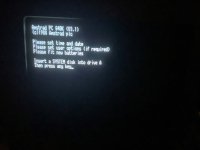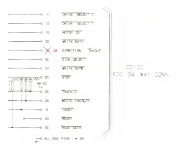jarcher1701
Experienced Member
- Joined
- Oct 24, 2023
- Messages
- 58
Hello. I'm hoping there are some resident Amstrad experts who may be able to assist.
I recently acquired an Amstrad PC1640 with an 'MD' monochrome display. It starts to go through the initialisation checks but never reaches a prompt. After showing 'Please Wait....' it displays the following error message: " Error: Faulty Floppy Disk Controller or Disk Drive".
The hard disk was removed by the previous owner before the sale. I've removed the hard disk controller card that came with the machine. The original 5.25 floppy drive is connected to the onboard FDC via the ribbon cable and is powered with the onboard Molex cable. With or without the drive connected it displays the error message every time.
There was only one occasion where it didn't display the message and instead mentioned replacing batteries. This has not reoccurred.
I've taken apart the machine, cleaned it and re-seated all socketed chips. No change.
Someone suggested adding the 4 AA batteries. I've done this, and checked the battery wires for continuity to the board and it seems fine, but there's no change.
More detail is provided here. https://www.vogons.org/viewtopic.php?f=46&t=96798&p=1205534#p1205534
Many thanks in advance for anyone that can help.
I recently acquired an Amstrad PC1640 with an 'MD' monochrome display. It starts to go through the initialisation checks but never reaches a prompt. After showing 'Please Wait....' it displays the following error message: " Error: Faulty Floppy Disk Controller or Disk Drive".
The hard disk was removed by the previous owner before the sale. I've removed the hard disk controller card that came with the machine. The original 5.25 floppy drive is connected to the onboard FDC via the ribbon cable and is powered with the onboard Molex cable. With or without the drive connected it displays the error message every time.
There was only one occasion where it didn't display the message and instead mentioned replacing batteries. This has not reoccurred.
I've taken apart the machine, cleaned it and re-seated all socketed chips. No change.
Someone suggested adding the 4 AA batteries. I've done this, and checked the battery wires for continuity to the board and it seems fine, but there's no change.
More detail is provided here. https://www.vogons.org/viewtopic.php?f=46&t=96798&p=1205534#p1205534
Many thanks in advance for anyone that can help.


